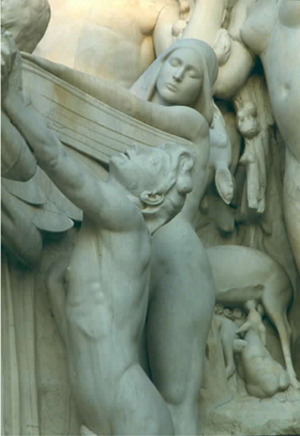
HARRISBURG, Pa. (AP) – Standing tall and naked, the marble statues just outside the state Capitol’s main entrance have been ogled and admired by passers-by for the last century.
Art enthusiasts see the statuary groups as a national treasure.
Preservationists see them as contributing to the grandiose decor that some say makes the most beautiful statehouse in the land.
Schoolchildren see the sculptures and giggle over the 27 figures’ nakedness, something that civic groups around the turn of the 20th century tried to squelch by ordering the artist to place covers over the male genitalia.
But the statuary that depicts sculptor George Grey Barnard’s representation of the spiritual burden carried by mankind has turned into a financial burden on taxpayers.
The art, known as Life of Humanity, has cost millions of dollars over the years in maintenance and upkeep since its dedication on Oct. 4, 1911.
It now costs about $120,000 a year to maintain the sculpture that Barnard, a native of Bellefonte, Centre County, was paid $180,000 to produce, which is about $4.3 million by today’s standards, according to Jason Wilson, research historian for the Capitol Preservation Committee.
That raises a question about whether in these tough economic times the upkeep of this piece of art that sits outside exposed to the elements has gotten too rich for taxpayers.
“In times of financial belt-tightening, everyone must make decisions whether to fund the necessities or the niceties. A hundred thousand dollars every year would fill many potholes across Pennsylvania,” said Matthew Brouillette, president of the conservative-leaning Commonwealth Foundation of Harrisburg.
“Instead of charging the taxpayers, the options include finding a private, nonprofit art supporter to maintain these statues or replace them with less opulent and less costly Capitol decor. My guess is that taxpayers picking up the tab would be for the latter.”
But the Barnard sculptures are a rare example of Symbolist sculpture in America, making them a national treasure and deserving to be preserved, said Brian Hack, an adjunct professor of American Art at the City University of New York, Kingsborough, and Barnard scholar.
“He saw those two works as evoking what he saw as universal truth and he saw them as a way to heal humankind and make better humanity. There’s a whole lesson there he wanted people to understand from it, and it’s kind of sad it’s so expensive to maintain,” Hack said.
The statuary has undergone several major restorations over the past century, including one in the mid-1990s that cost $1.1 million.
Some of the maintenance work done in the early part of the last century did more harm than good when conservators applied treatments that removed the Italian Carrara marble’s natural skin, making the statues more susceptible to damage, said Christopher Ellis, the committee’s senior preservation project manager.
To avoid or delay another costly restoration, the preservation committee 15 years ago began a routine maintenance program to keep the complicated piece of artwork clean and intact. This year, it entered into a five-year contract with Conservation Solutions of Washington, D.C., totaling more than $600,000, to perform that work.
“Sometimes we find tips get knocked off by nature, erosion or with old repairs, the adhesive or grout has fallen off. In fact, we found a fingertip just laying on the statue this year,” he said.
The Barnard statuary is one of the costliest pieces of Capitol artwork for the committee to maintain. With the cutting of the preservation committee’s state appropriation from $4 million in 2008-09 to just below $2 million now, the cost of upkeep for this piece of artwork represents a significant share.
Still, Ellis and committee members think that is an investment worth making.
“We have had people who come to the Capitol, whether they are tourists from outside the United States or even people here in the United States, who recognize the great value of the sculpture. To me, they are just extraordinary sculptured pieces,” said Rep. Paul Clymer, R-Bucks, who chairs the preservation committee.
The only way art like the Barnard statuary would find its way into a state government building today is if it were donated because “there simply is no government money available,” said Tom Darr, the state courts’ deputy court administrator who also serves on the preservation committee.
Darr oversaw the construction of the Pennsylvania Judicial Center that opened in 2009 in the Capitol Complex. The project’s $116 million budget left a wide open plaza and atrium devoid of art that to this day, Darr is racking his brain to try to remedy.
As for the cost of maintaining the Barnard statuary, Darr said it’s the price that has to be paid to preserve a part of Pennsylvania’s heritage.
“While we are all focused on the needs for more jobs and having safety nets and all the terribly important things, it’s worth having a little bit of heritage and artistic culture that gives people a feeling about where we came from,” Darr said.
___
Online:
___
Information from: The Patriot-News, http://www.pennlive.com/patriotnews
Copyright 2011 Associated Press. All rights reserved. This material may not be published, broadcast, rewritten, or redistributed.
AP-WF-09-27-11 1526GMT

